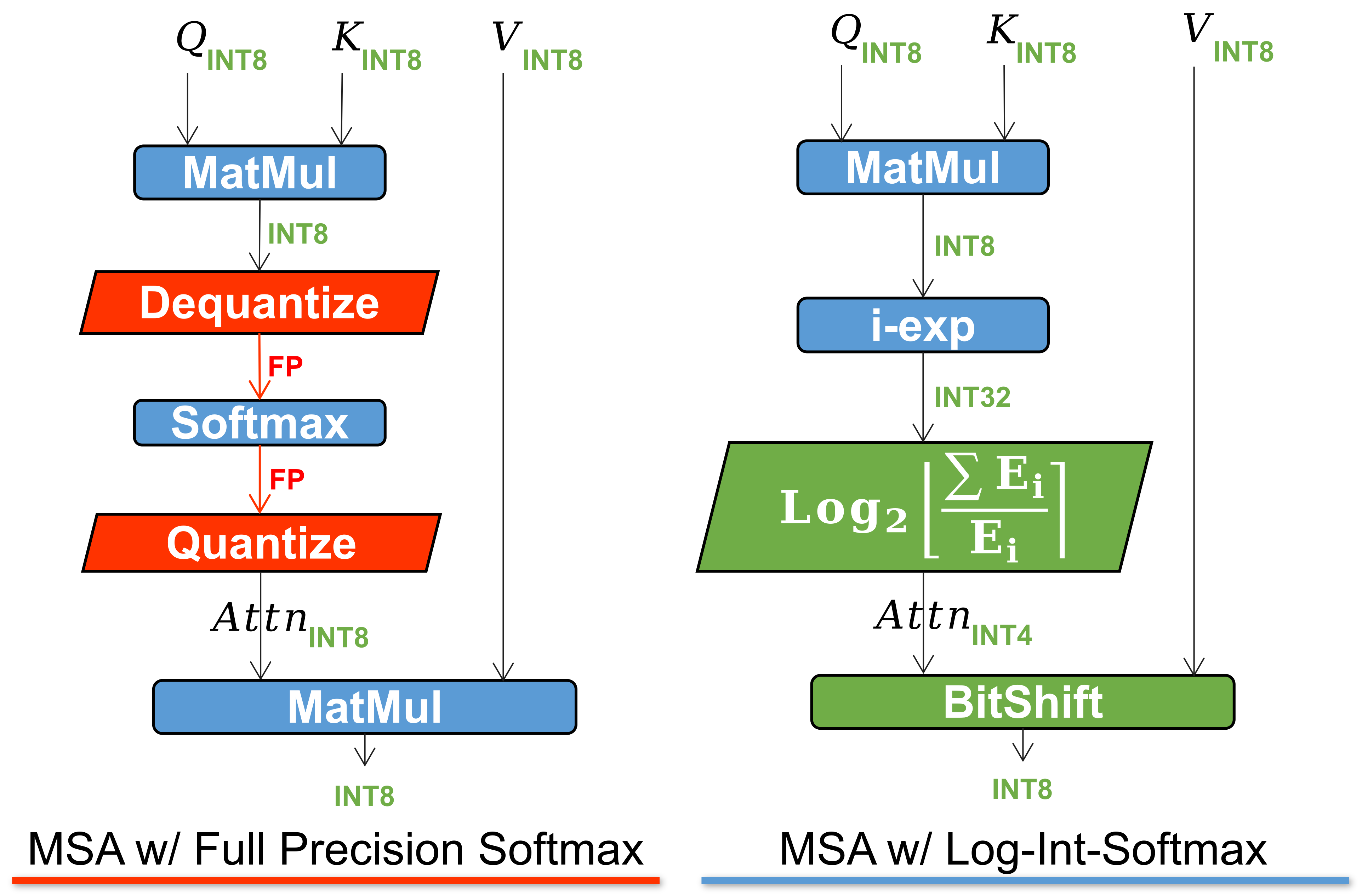This repo contains the official implementation of "FQ-ViT: Post-Training Quantization for Fully Quantized Vision Transformer".
Transformer-based architectures have achieved competitive performance in various CV tasks. Compared to the CNNs, Transformers usually have more parameters and higher computational costs, presenting a challenge when deployed to resource-constrained hardware devices.
Most existing quantization approaches are designed and tested on CNNs and lack proper handling of Transformer-specific modules. Previous work found there would be significant accuracy degradation when quantizing LayerNorm and Softmax of Transformer-based architectures. As a result, they left LayerNorm and Softmax unquantized with floating-point numbers. We revisit these two exclusive modules of the Vision Transformers and discover the reasons for degradation. In this work, we propose the FQ-ViT, the first fully quantized Vision Transformer, which contains two specific modules: Power-of-Two Factor (PTF) and Log-Int-Softmax (LIS).
These two figures below show that there exists serious inter-channel variation in Vision Transformers than CNNs, which leads to unacceptable quantization errors with layer-wise quantization.
Taking the advantages of both layer-wise and channel-wise quantization, we propose PTF for LayerNorm's quantization. The core idea of PTF is to equip different channels with different Power-of-Two Factors, rather than different quantization scales.
The storage and computation of attention map is known as a bottleneck for transformer structures, so we want to quantize it to extreme lower bit-width (e.g. 4-bit). However, if directly implementing 4-bit uniform quantization, there will be severe accuracy degeneration. We observe a distribution centering at a fairly small value of the output of Softmax, while only few outliers have larger values close to 1. Based on the following visualization, Log2 preserves more quantization bins than uniform for the small value interval with dense distribution.
Combining Log2 quantization with i-exp, which is a polynomial approximation of exponential function presented by I-BERT, we propose LIS, an integer-only, faster, low consuming Softmax.
The whole process is visualized as follow.
- Clone this repo.
git clone https://github.com/megvii-research/FQ-ViT.git
cd FQ-ViT- Create a conda virtual environment and activate it.
conda create -n fq-vit python=3.7 -y
conda activate fq-vit- Install PyTorch and torchvision. e.g.,
conda install pytorch=1.7.1 torchvision cudatoolkit=10.1 -c pytorchYou should download the standard ImageNet Dataset.
├── imagenet
│ ├── train
│
│ ├── val
Example: Evaluate quantized DeiT-S with MinMax quantizer and our proposed PTF and LIS.
python test_quant.py deit_small <YOUR_DATA_DIR> --quant --ptf --lis --quant-method minmax
-
deit_small: model architecture, which can be replaced bydeit_tiny,deit_base,vit_base,vit_large,swin_tiny,swin_smallandswin_base. -
--quant: whether to quantize the model. -
--ptf: whether to use Power-of-Two Factor Integer Layernorm. -
--lis: whether to use Log-Integer-Softmax. -
--quant-method: quantization methods of activations, which can be chosen fromminmax,ema,percentileandomse.
We compare our methods with several post-training quantization strategies, including MinMax, EMA, Percentile, OMSE, Bit-Split, and PTQ for ViT.
The following results are evaluated on ImageNet.
| Method | W/A/Attn Bits | DeiT-T | DeiT-S | DeiT-B | ViT-B | ViT-L | Swin-T | Swin-S | Swin-B |
|---|---|---|---|---|---|---|---|---|---|
| Full Precision | 32/32/32 | 72.21 | 79.85 | 81.85 | 84.53 | 85.81 | 81.35 | 83.20 | 83.60 |
| MinMax | 8/8/8 | 70.94 | 75.05 | 78.02 | 23.64 | 3.37 | 64.38 | 74.37 | 25.58 |
| EMA | 8/8/8 | 71.17 | 75.71 | 78.82 | 30.30 | 3.53 | 70.81 | 75.05 | 28.00 |
| Percentile | 8/8/8 | 71.47 | 76.57 | 78.37 | 46.69 | 5.85 | 78.78 | 78.12 | 40.93 |
| OMSE | 8/8/8 | 71.30 | 75.03 | 79.57 | 73.39 | 11.32 | 79.30 | 78.96 | 48.55 |
| Bit-Split | 8/8/8 | - | 77.06 | 79.42 | - | - | - | - | - |
| PTQ for ViT | 8/8/8 | - | 77.47 | 80.48 | - | - | - | - | - |
| Ours | 8/8/8 | 71.61 | 79.17 | 81.20 | 83.31 | 85.03 | 80.51 | 82.71 | 82.97 |
| Ours | 8/8/4 | 71.07 | 78.40 | 80.85 | 82.68 | 84.89 | 80.04 | 82.47 | 82.38 |
If you find this repo useful in your research, please consider citing the following paper:
@inproceedings{lin2022fqvit,
title={FQ-ViT: Post-Training Quantization for Fully Quantized Vision Transformer},
author={Lin, Yang and Zhang, Tianyu and Sun, Peiqin and Li, Zheng and Zhou, Shuchang},
booktitle={Proceedings of the Thirty-First International Joint Conference on Artificial Intelligence, {IJCAI-22}},
pages={1173--1179},
year={2022}
}Welcome to be a member (or an intern) of our team if you are interested in Quantization, Pruning, Distillation, Self-Supervised Learning and Model Deployment.
Please send your resume to sunpeiqin@megvii.com.


